Averting BER Floor with Iterative Source and Channel Decoding for Layered Steered Space-Time Codes
Abstract
1. Introduction
1.1. Related Work
1.2. Novelty and Contribution
- Investigating the performance of iteratively decoded LSSTC-SP scheme using state-of-the-art HEVC/H.265 source encoder.
- Quantifying the effects of SBC on the attainable performance of three-stage system via extrinsic information transfer (EXIT) charts for mobile video transmission over the correlated Rayleigh channel.
- Demonstrating the effects of on the BER and peak signal-to-noise ratio (PSNR) performances of the three-stage system.
2. Overview of Layered Steered Space-Time Codes
2.1. Transmitter Model
2.2. Receiver Model
3. Source Encoding and Soft-Bit Source Decoding
- The picture parameter set used in H.264 stores shareable information which is rarely changed and is mostly used for decoding operation. The H.265 standard refers to this as the video parameter set (VPS).
- For the purpose of enabling video telephony and broadcast or streaming applications, the network abstraction layer (NAL) is designed which is an integral part of both the H.264 and H.265 standards.
- The concept of slices is adopted in both the H.264 and H.265 video standards. Slicing is normally used to avoid data losses by recovering the affected segments.
- Supplemental enhancement information (SEI) and video usability information (VUI) metadata are supported in both the H.264 and H.265 standards. These are put into the coded video as additional information and indicate the timing information, identify the colour space in the content, and provide other display related statistics.
4. Simulation Results and EXIT Analysis
5. Future Work
6. Conclusions
Author Contributions
Funding
Institutional Review Board Statement
Informed Consent Statement
Data Availability Statement
Acknowledgments
Conflicts of Interest
References
- Chowdhury, Z.M.; Shahjalal, M.; Ahmed, S.; Jang, Y.M. 6G wireless communication systems: Applications, requirements, technologies, challenges, and research directions. IEEE Open J. Commun. Soc. 2020, 1, 957–975. [Google Scholar] [CrossRef]
- Banerjee, A.; Vaesen, K.; Visweswaran, A.; Khalaf, K.; Shi, Q.; Brebels, S.; Guermandi, D.; Tsai, C.H.; Nguyen, J.; Medra, A.; et al. Millimeter-wave transceivers for wireless communication, radar, and sensing. In Proceedings of the 2019 IEEE Custom Integrated Circuits Conference (CICC), Austin, TX, USA, 14–17 April 2019; pp. 1–11. [Google Scholar]
- C. Corp. Available online: https://www.cisco.com/c/en/us/solutions/serviceprovider/visual-networking-index-vni/index.html (accessed on 21 March 2021).
- Shannon, C. A mathematical theory of communication. Bell Syst. Tech. J. 1948, 27, 379–423. [Google Scholar] [CrossRef]
- Massey, J.L. Joint Source and Channel Coding; Massachusetts Institute of Tech Cambridge Electronic Systems Lab: Cambridge, MA, USA, 1977. [Google Scholar]
- Hanzo, L. EXIT-chart optimized short block codes for iterative joint source and channel decoding in H. 264 video telephony. IEEE Trans. Veh. Technol. 2009, 58, 4306–4315. [Google Scholar]
- Minallah, N.; El-Hajjar, M.; Hanzo, L.; Iterative, H. 264 Source and Channel Decoding Using Sphere Packing Modulation Aided Layered Steered Space-Time Codes. In Proceedings of the 2010 IEEE International Conference on Communications, Cape Town, South Africa, 23–27 May 2010; pp. 1–5. [Google Scholar]
- Berrou, C.; Glavieux, A.; Thitimajshima, P. Near Shannon limit error-correcting coding and decoding: Turbo-codes. 1. In Proceedings of the ICC’93-IEEE International Conference on Communications, Geneva, Switzerland, 23–26 May 1993; Volume 2, pp. 1064–1070. [Google Scholar]
- Gortz, N. Iterative source-channel decoding using soft-in/soft-out decoders. In Proceedings of the 2000 IEEE International Symposium on Information Theory, Sorento, Italy, 25–30 June 2000; p. 173. [Google Scholar]
- Adrat, M.; Vary, P. Iterative source-channel decoding: Improved system design using EXIT charts. EURASIP J. Adv. Signal. Process. 2005, 2005, 178541. [Google Scholar] [CrossRef][Green Version]
- Wang, X.; Poor, H.V. Iterative (turbo) soft interference cancellation and decoding for coded CDMA. IEEE Trans. Commun. 1999, 47, 1046–1061. [Google Scholar] [CrossRef]
- Clevorn, T.; Schmalen, L.; Vary, P.; Adrat, M. On redundant index assignments for iterative source-channel decoding. IEEE Commun. Lett. 2008, 12, 514–516. [Google Scholar] [CrossRef][Green Version]
- Alexei, A.; Kramer, G.; Brink, S.T. Extrinsic information transfer functions: Model and erasure channel properties. IEEE Trans. Inf. Theory 2004, 50, 2657–2673. [Google Scholar]
- Lajos, H.; Alamri, O.; El-Hajjar, M.; Wu, N. Near-Capacity Multi-Functional MIMO Systems: Sphere-Packing, Iterative Detection and Cooperation; John Wiley & Sons: Hoboken, NJ, USA, 2009. [Google Scholar]
- Hanzo, L.; El-Hajjar, M.; Alamri, O. Near-capacity wireless transceivers and cooperative communications in the MIMO era: Evolution of standards, waveform design, and future perspectives. Proc. IEEE 2011, 99, 1343–1385. [Google Scholar] [CrossRef][Green Version]
- Vahid, T.; Jafarkhani, H. A differential detection scheme for transmit diversity. IEEE J. Sel. Areas Commun. 2000, 18, 1169–1174. [Google Scholar]
- Wolniansky, W.P.; Foschini, G.J.; Golden, G.D.; Valenzuela, R.A. V-BLAST: An architecture for realizing very high data rates over the rich-scattering wireless channel. In Proceedings of the 1998 URSI International Symposium on Signals, Systems, and Electronics, Pisa, Italy, 29 September–2 October 1998; pp. 295–300. [Google Scholar]
- Vahid, T.; Naguib, A.; Seshadri, N.; Calderbank, A.R. Combined array processing and space-time coding. IEEE Trans. Inf. Theory 1999, 45, 1121–1128. [Google Scholar]
- Blogh, S.J.; Blogh, J.; Hanzo, L.L. Third-Generation Systems and Intelligent Wireless Networking: Smart Antennas and Adaptive Modulation; John Wiley & Sons: Hoboken, NJ, USA, 2002. [Google Scholar]
- Khalil, A.; Awan, M.A.; Khan, H.U.; Khan, A.S. On the Performance of Wireless Video Communication Using Iterative Joint Source Channel Decoding and Transmitter Diversity Gain Technique. Wirel. Commun. Mob. Comput. 2020, 2020, 16. [Google Scholar] [CrossRef]
- El-Hajjar, M.; Alamri, O.; Ng, S.X.; Hanzo, L. Turbo detection of precoded sphere packing modulation using four transmit antennas for differential space-time spreading. IEEE Trans. Wirel. Commun. 2008, 7, 943–952. [Google Scholar] [CrossRef]
- Minallah, N.; Ullah, K.; Frnda, J.; Cengiz, K.; Javed, M.A. Transmitter Diversity Gain Technique Aided Irregular Channel Coding for Mobile Video Transmission. Entropy 2021, 23, 235. [Google Scholar] [CrossRef]
- Minallah, N.; Ahmed, I.; Ijaz, M.; Khan, A.S.; Hasan, L.; Rehman, A. On the Performance of Self-Concatenated Coding for Wireless Mobile Video Transmission Using DSTS-SP-Assisted Smart Antenna System. Wirel. Commun. Mob. Comput. 2021, 2021, 10. [Google Scholar] [CrossRef]
- Minallah, N.; Ullah, K.; Frnda, J.; Hasan, L.; Nedoma, J. On the Performance of Video Resolution, Motion and Dynamism in Transmission Using Near-Capacity Transceiver for Wireless Communication. Entropy 2021, 23, 562. [Google Scholar] [CrossRef] [PubMed]
- Khan, U.H.; Minallah, N.; Masood, A.; Khalil, A.; Frnda, J.; Nedoma, J. Performance Analysis of Sphere Packed Aided Differential Space-Time Spreading with Iterative Source-Channel Detection. Sensors 2021, 21, 5461. [Google Scholar] [CrossRef] [PubMed]
- Arora, K.; Singh, J.; Randhawa, Y.S. A survey on channel coding techniques for 5G wireless networks. Telecommun. Syst. 2020, 73, 637–663. [Google Scholar] [CrossRef]
- Samayoa, Y.; Ostermann, J. Parameter Selection for a Video Communication System based on HEVC and Channel Coding. In Proceedings of the 2020 IEEE Latin-American Conference on Communications (LATINCOM), Santo Domingo, Dominican Republic, 18–20 November 2020; pp. 1–5. [Google Scholar]
- Hamdoun, H.; Nazir, S.; Alzubi, J.A.; Laskot, P.; Alzubi, O.A. Performance benefits of network coding for HEVC video communications in satellite networks. Iran. J. Electr. Electron. Eng. 2021, 17, 1956. [Google Scholar]
- Topiwala, P.; Dai, W.; Bush, K. Wireless video communications over lossy channels. In Applications of Digital Image Processing XLIII; International Society for Optics and Photonics: Bellingham, DC, USA, 2020. [Google Scholar]
- Khernache, A.M.B.; Benmoussa, Y.; Boukhobza, J.; Menard, D. HEVC hardware vs software decoding: An objective energy consumption analysis and comparison. J. Syst. Archit. 2021, 115, 102004. [Google Scholar] [CrossRef]
- Thanuja, M.; Talagala, D.; Arachchi, H.K.; Hewage, C.; Fernando, A. A Decoding-Complexity and Rate-Controlled Video-Coding Algorithm for HEVC. Future Internet 2020, 12, 120. [Google Scholar]
- Costero, L.; Iranfar, A.; Zapater, M.; Igual, F.D.; Olcoz, K.; Atienza, D. Resource management for power-constrained HEVC transcoding using reinforcement learning. IEEE Trans. Parallel Distrib. Syst. 2020, 31, 2834–2850. [Google Scholar] [CrossRef]
- El-Hajjar, M.; Alamri, O.; Wang, J.; Zummo, S.; Hanzo, L. Layered steered space-time codes using multi-dimensional sphere packing modulation. IEEE Trans. Wirel. Commun. 2009, 8, 3335–3340. [Google Scholar] [CrossRef]
- Ju-Hong, L.; Cheng, C. Spatial correlation of multiple antenna arrays in wireless communication systems. Prog. Electromagn. Res. 2012, 132, 347–368. [Google Scholar]
- Mesleh, Y.R.; Haas, H.; Sinanovic, S.; Ahn, C.W.; Yun, S. Spatial modulation. IEEE Trans. Veh. Technol. 2008, 57, 2228–2241. [Google Scholar] [CrossRef]
- Garcia-Frias, J. Joint source-channel decoding of correlated sources over noisy channels. In Proceedings of the DCC 2001, Data Compression Conference, Snowbird, UT, USA, 27–29 March 2001; pp. 283–292. [Google Scholar]
- Garcia, R.; Kalva, H. Subjective evaluation of HEVC and AVC/H. 264 in mobile environments. IEEE Trans. Consum. Electron. 2014, 60, 116–123. [Google Scholar] [CrossRef]
- Flynn, D.; Marpe, D.; Naccari, M.; Nguyen, T.; Rosewarne, C.; Sharman, K.; Sole, J.; Xu, J. Overview of the range extensions for the HEVC standard: Tools, profiles, and performance. IEEE Trans. Circuits Syst. Video Technol. 2015, 26, 4–19. [Google Scholar] [CrossRef]
- Alfaqheri, T.T.; Sadka, A.H. Low delay error resilience algorithm for H. 265| HEVC video transmission. J. Real-Time Image Process. 2020, 17, 2047–2063. [Google Scholar] [CrossRef]
- El-Hajjar, M.; Hanzo, L. EXIT charts for system design and analysis. IEEE Commun. Surv. Tutor. 2013, 16, 127–153. [Google Scholar] [CrossRef]
- Minallah, N.; Butt, M.F.U.; Khan, I.U.; Ahmed, I.; Khattak, K.S.; Qiao, G.; Liu, S. Analysis of near-capacity iterative decoding schemes for wireless communication using EXIT charts. IEEE Access 2020, 8, 124424–124436. [Google Scholar] [CrossRef]
- Robertson, P.; Villebrun, E.; Hoeher, P. A comparison of optimal and sub-optimal MAP decoding algorithms operating in the log domain. In Proceedings of the IEEE International Conference on Communications ICC’95, Seattle, WA, USA, 18–22 June 1995; Volume 2, pp. 1009–1013. [Google Scholar]
- Sullivan, G.J.; Ohm, J.R.; Han, W.J.; Wiegand, T. Overview of the high efficiency video coding (HEVC) standard. IEEE Trans. Circuits Syst. Video Technol. 2012, 22, 1649–1668. [Google Scholar] [CrossRef]
- Sullivan, J.G.; Boyce, J.M.; Chen, Y.; Ohm, J.; Segall, C.A.; Vetro, A. Standardized extensions of high efficiency video coding (HEVC). IEEE J. Sel. Top. Signal. Process. 2013, 7, 1001–1016. [Google Scholar] [CrossRef]
- Stockhamme, T.; Hannuksela, M.M.; Wiegand, T.H. 264/AVC in wireless environments. IEEE Trans. Circuits Syst. Video Technol. 2003, 13, 657–673. [Google Scholar] [CrossRef]
- Psannis, K.E. HEVC in wireless environments. J. Real-Time Image Process. 2016, 12, 509–516. [Google Scholar] [CrossRef]
- Fingscheidt, T.; Vary, P. Softbit speech decoding: A new approach to error concealment. IEEE Trans. Speech Audio Process. 2001, 9, 240–251. [Google Scholar] [CrossRef]
- Adrat, M.; Vary, P.; Spittka, J. Iterative source-channel decoder using extrinsic information from softbit-source decoding. In Proceedings of the 2001 IEEE International Conference on Acoustics, Speech, and Signal Processing, Seattle, WA, USA, 18–22 June 1995; Volume 4, pp. 2653–2656. [Google Scholar]
- Minallah, N. Low-Bit-Rate Joint Source-Channel Decoding Aided Wireless Video Communications. Ph.D. Thesis, University of Southampton, Southampton, UK, 2010. [Google Scholar]
- Kliewer, J.; Goertz, N.; Mertins, A. Iterative source-channel decoding with Markov random field source models. IEEE Trans. Signal. Process. 2006, 54, 3688–3701. [Google Scholar] [CrossRef]
- Ten Brink, S. Designing iterative decoding schemes with the extrinsic information transfer chart. AEU Int. J. Electron. Commun. 2000, 54, 389–398. [Google Scholar]
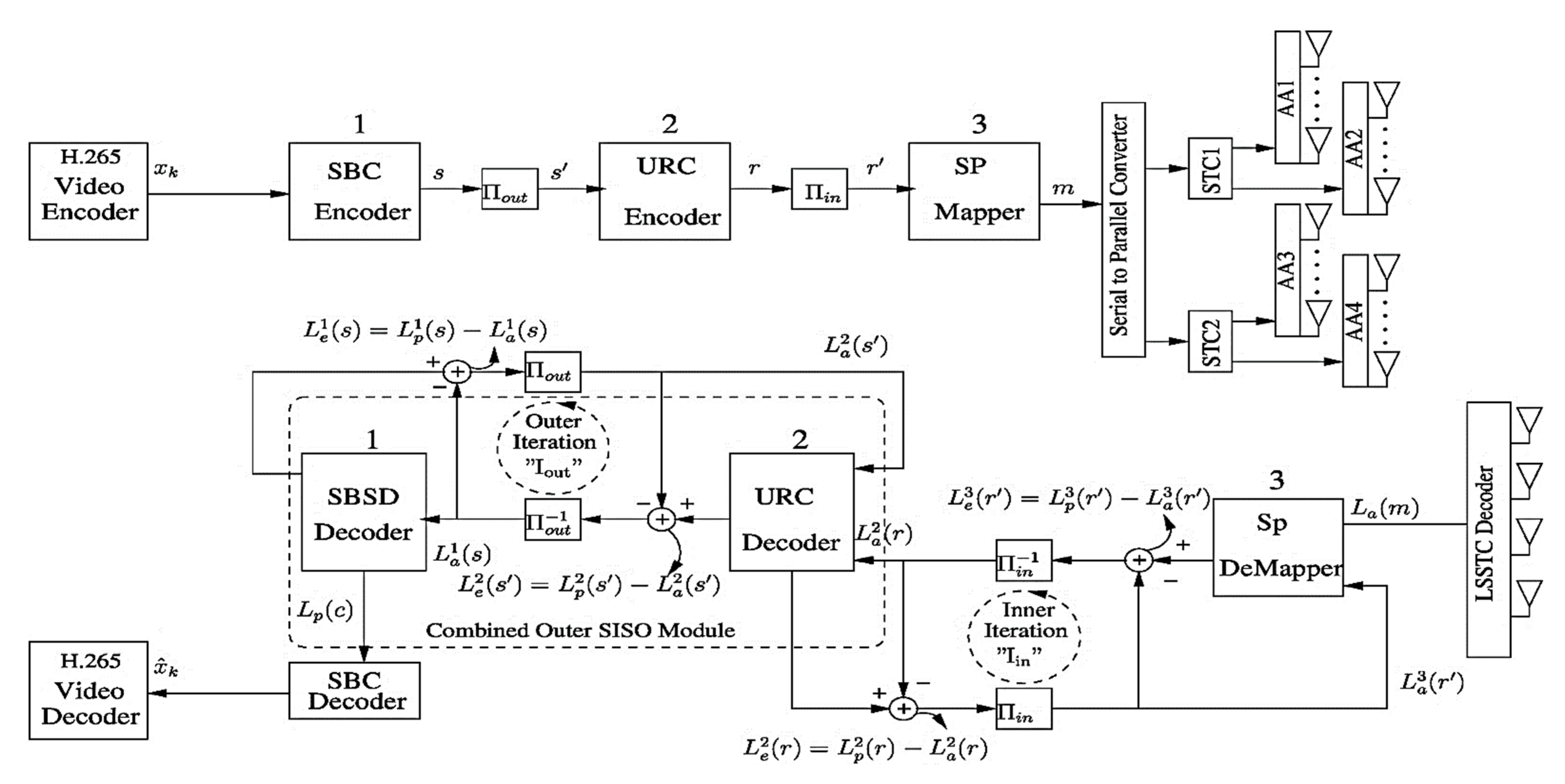
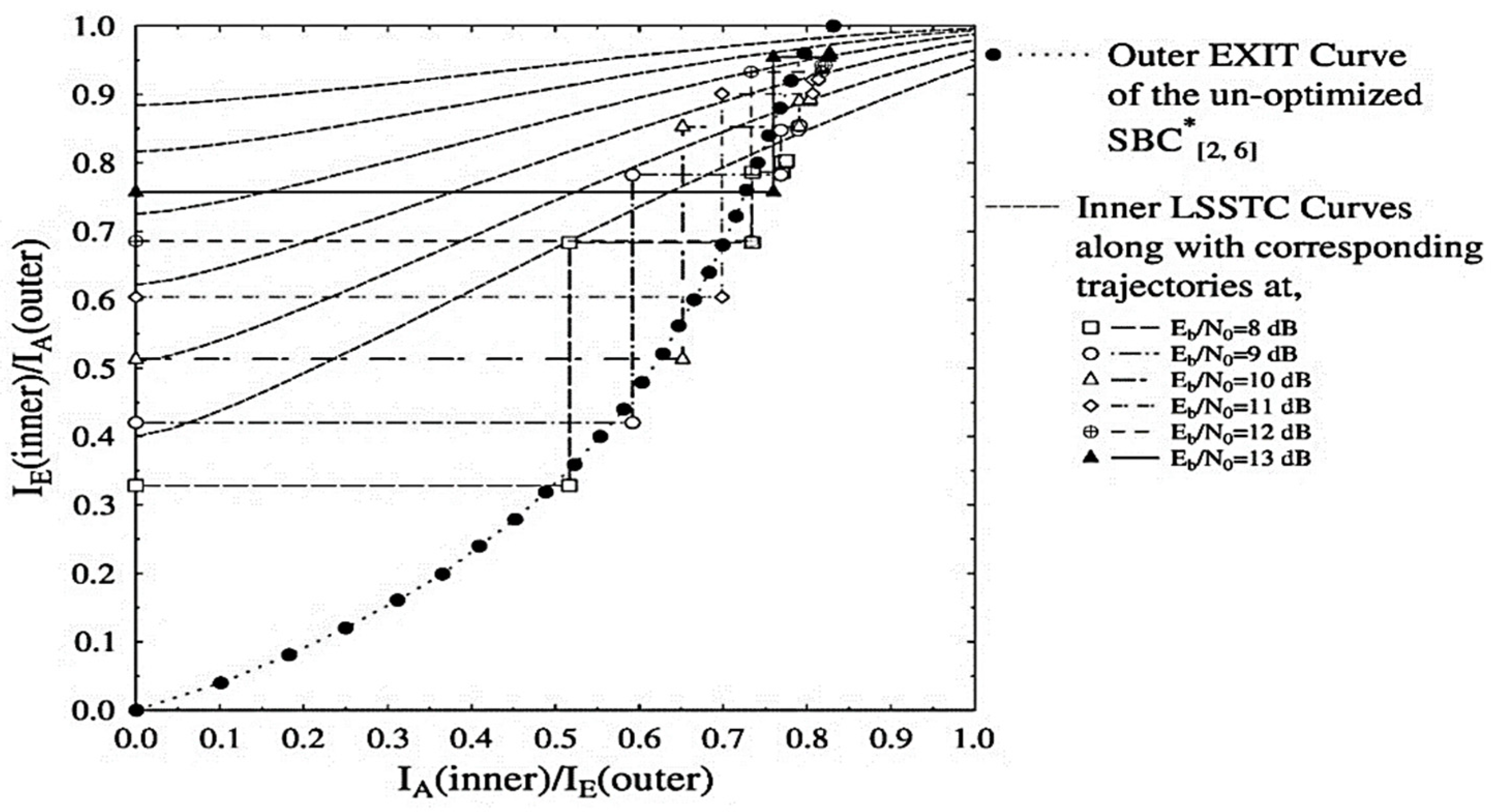
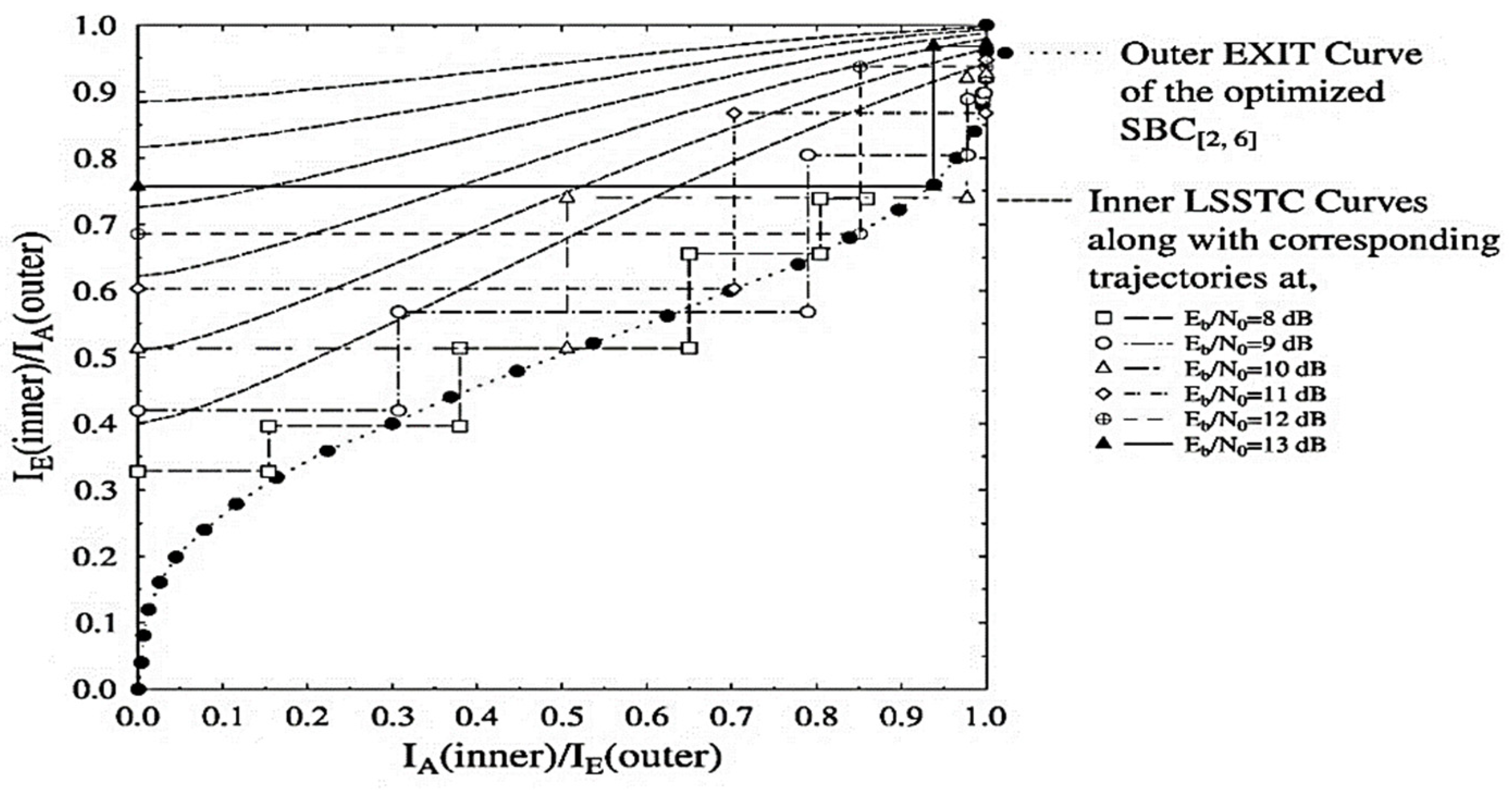
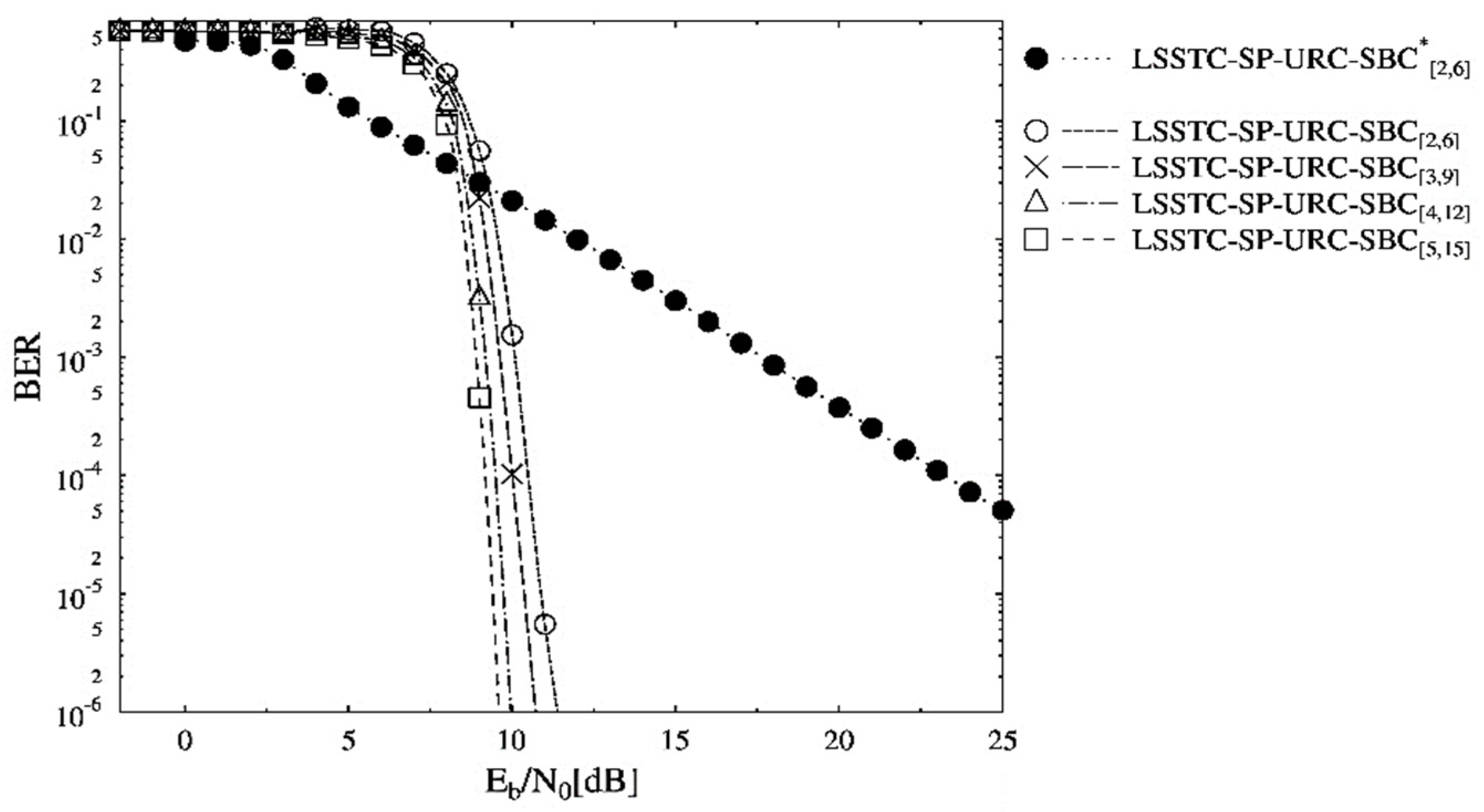
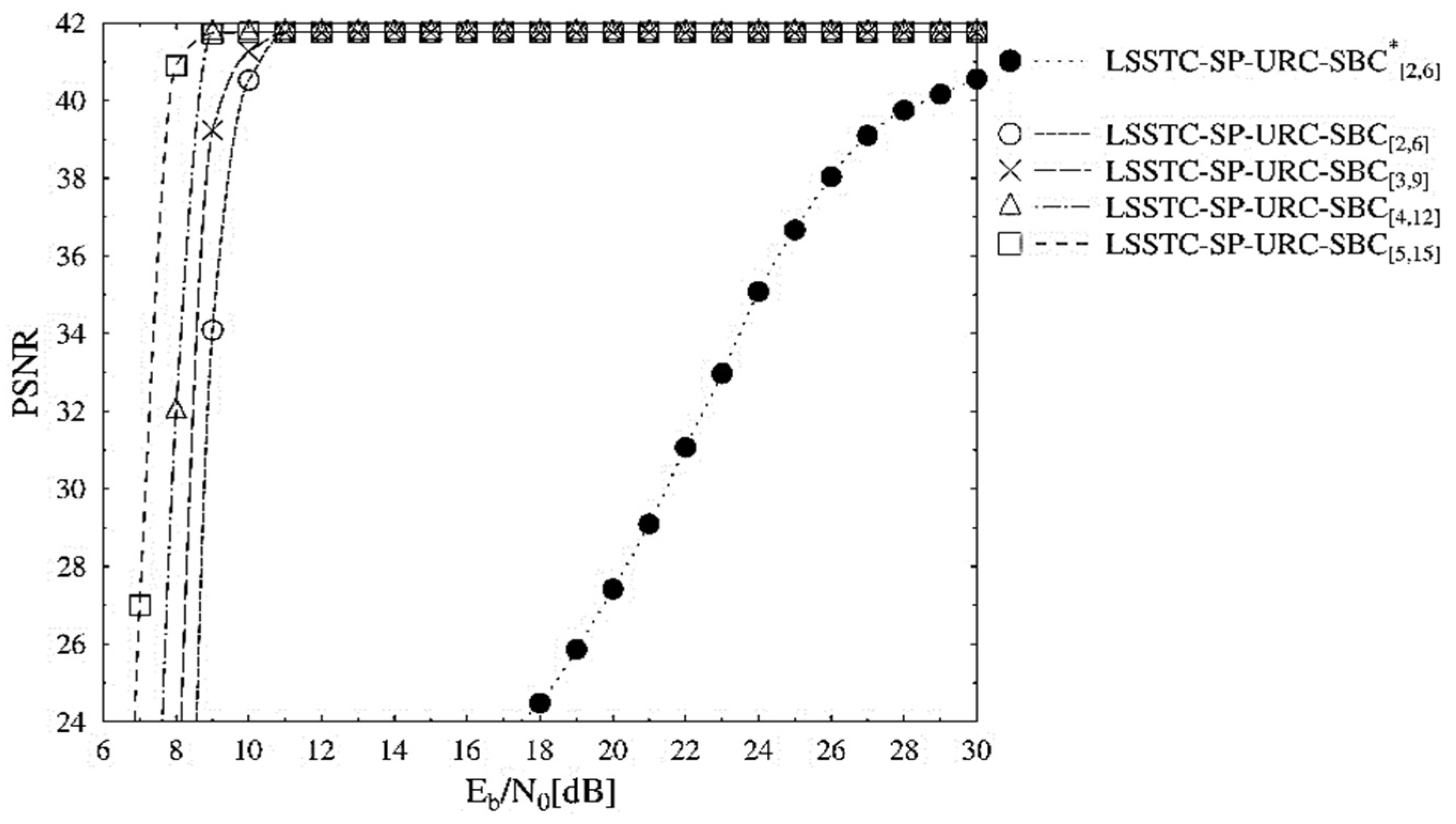

| References | Methods and Parameters | Video Coding Standard |
|---|---|---|
| [20] | Investigated the performance of SBC schemes using DSTS-SP for the two-stage system | H.264 |
| [22] | Comparison of the regular and irregular error protection schemes using DSTS-SP for the two-stage system | H.264 |
| [23] | Investigated the performance of Self-concatenated coding for the two-stage system | H.264 |
| [24] | Comparison of convergent and non-convergent coding schemes for diverse video environments | H.265 |
| [25] | Investigated the effects of varying on the BER and convergence performances for the two-stage system | H.264 |
| [26] | Comparison of LDPC and polar codes for improvements in 5G networks | Not deployed |
| [27] | Presented a novel parameter for distortion measurement and offered a strategy to mitigate distortions | H.265 |
| [28] | Systematic network coding and physical layer turbo coding for video transmission over satellite channel | H.265 |
| Ours | Investigating low complexity SBCs with combinational gain technique of LSSTC for the three-stage system | H.265 |
| SBC Type | Symbols in Decimals | |
|---|---|---|
| Un-optimized | 0, 16, 32, 48 | 1 |
| 0, 22, 41, 63 | 3 | |
| 0, 78, 149, 219, 291, 365, 438, 504 | 4 | |
| 0, 286, 557, 819, 1099, 1365, 1638, 1912, 2183, 2457, 2730, 2996, 3276, 3538, 3809, 4095 | 5 | |
| 0, 1086, 2141, 3171, 4251, 5285, 6342, 7416, 8471, 9513, 10570, 11636, 12684, 13746, 14801, 15855, 16911, 17969, 19026, 20076, 21140, 22186, 23241, 24311, 25368, 26406, 27461, 28539, 29571, 30653, 31710, 32736 | 6 |
| Parameters | Value | Parameters | Value |
|---|---|---|---|
| Source Code | H.265/HEVC | Transmitter AAs | 4 |
| Source Bit-Rate | 64 kbps | Receiver Antennas | 4 |
| Frame Rate | 15 fps | Intermediate Code | URC |
| Slices per Frame | 9 | Interleaving Bits | 10,000 |
| Overall Code Rate | 1/3 | Video Sequence | QCIF Akiyo |
| Number of CTUs per slice | 60 | Normalized Doppler Frequency | 0.01 |
| Frames to be Encoded | 300 | Modulation Scheme | SP |
| Error Protection Scheme | SBC | Channel | Rayleigh Fading |
Publisher’s Note: MDPI stays neutral with regard to jurisdictional claims in published maps and institutional affiliations. |
© 2021 by the authors. Licensee MDPI, Basel, Switzerland. This article is an open access article distributed under the terms and conditions of the Creative Commons Attribution (CC BY) license (https://creativecommons.org/licenses/by/4.0/).
Share and Cite
Minallah, N.; Ahmed, I.; Frnda, J.; Khattak, K.S. Averting BER Floor with Iterative Source and Channel Decoding for Layered Steered Space-Time Codes. Sensors 2021, 21, 6502. https://doi.org/10.3390/s21196502
Minallah N, Ahmed I, Frnda J, Khattak KS. Averting BER Floor with Iterative Source and Channel Decoding for Layered Steered Space-Time Codes. Sensors. 2021; 21(19):6502. https://doi.org/10.3390/s21196502
Chicago/Turabian StyleMinallah, Nasru, Ishtiaque Ahmed, Jaroslav Frnda, and Khurram S. Khattak. 2021. "Averting BER Floor with Iterative Source and Channel Decoding for Layered Steered Space-Time Codes" Sensors 21, no. 19: 6502. https://doi.org/10.3390/s21196502
APA StyleMinallah, N., Ahmed, I., Frnda, J., & Khattak, K. S. (2021). Averting BER Floor with Iterative Source and Channel Decoding for Layered Steered Space-Time Codes. Sensors, 21(19), 6502. https://doi.org/10.3390/s21196502






